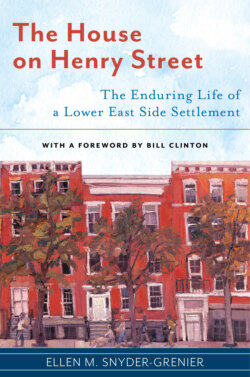Читать книгу The House on Henry Street - Ellen M. Snyder-Grenier - Страница 6
На сайте Литреса книга снята с продажи.
FOREWORD
ОглавлениеPRESIDENT BILL CLINTON
The first time I visited Henry Street Settlement was on a sweltering July afternoon in 1992—just hours before the Democratic National Convention was to convene at Madison Square Garden, a few miles north of the Settlement. The occasion was an outdoor town hall meeting, where I greeted the enthusiastic crowd gathered outside the Settlement’s Abrons Arts Center. As I looked around, I saw the best of America—young and old, immigrant and native born—all there because they wanted to create a better future for themselves and their families. And it was clear they cared deeply about their neighborhood, and their nation.
I knew that many came from humble origins, just as I had. It was an engaged group, and I was impressed by their insightful questions. I even referenced one in my acceptance speech for the Democratic nomination for President I delivered the next day. Among the many people I met at Henry Street was Danny Kronenfeld, then the agency’s executive director. I was so moved by his dedication to his community that I invited him to the Faces of Hope inaugural luncheon, one of 53 Americans invited to attend. I sat next to him that day, and learned even more about the Settlement.
My encounter with Henry Street in the early 1990s was just a brief moment in its long, full life. The organization was founded in 1893 by Lillian Wald, a 26-year-old nurse whose shock at witnessing the misery and poverty on the Lower East Side prompted her—in a moment she later called her “baptism of fire”—to take action. She moved—or “settled”—into the neighborhood and along with the other nurses who lived at the Settlement delivered health care and more to their impoverished neighbors.
Henry Street Settlement was established on the simple belief that everyone deserves a chance to live his or her best life story, and the more fortunate among us should do what we can to give them that chance. The Settlement continues today to open doors of opportunity for the neighborhood’s most vulnerable residents. It is deeply rooted in a community that has been home to wave after wave of new immigrants seeking a better life in America, helping them to realize their full potential to become engaged citizens, to find jobs and apartments, and to access health care, education, and the arts.
Inside this book you’ll get a glimpse of Henry Street Settlement’s 125 years and counting of serving Lower East Side residents, and all New Yorkers, and see how what they have done—and continue to do each and every day—helps build strong families, strong neighborhoods, and a strong nation. It’s been a remarkable journey, and thankfully it’s not over yet.
